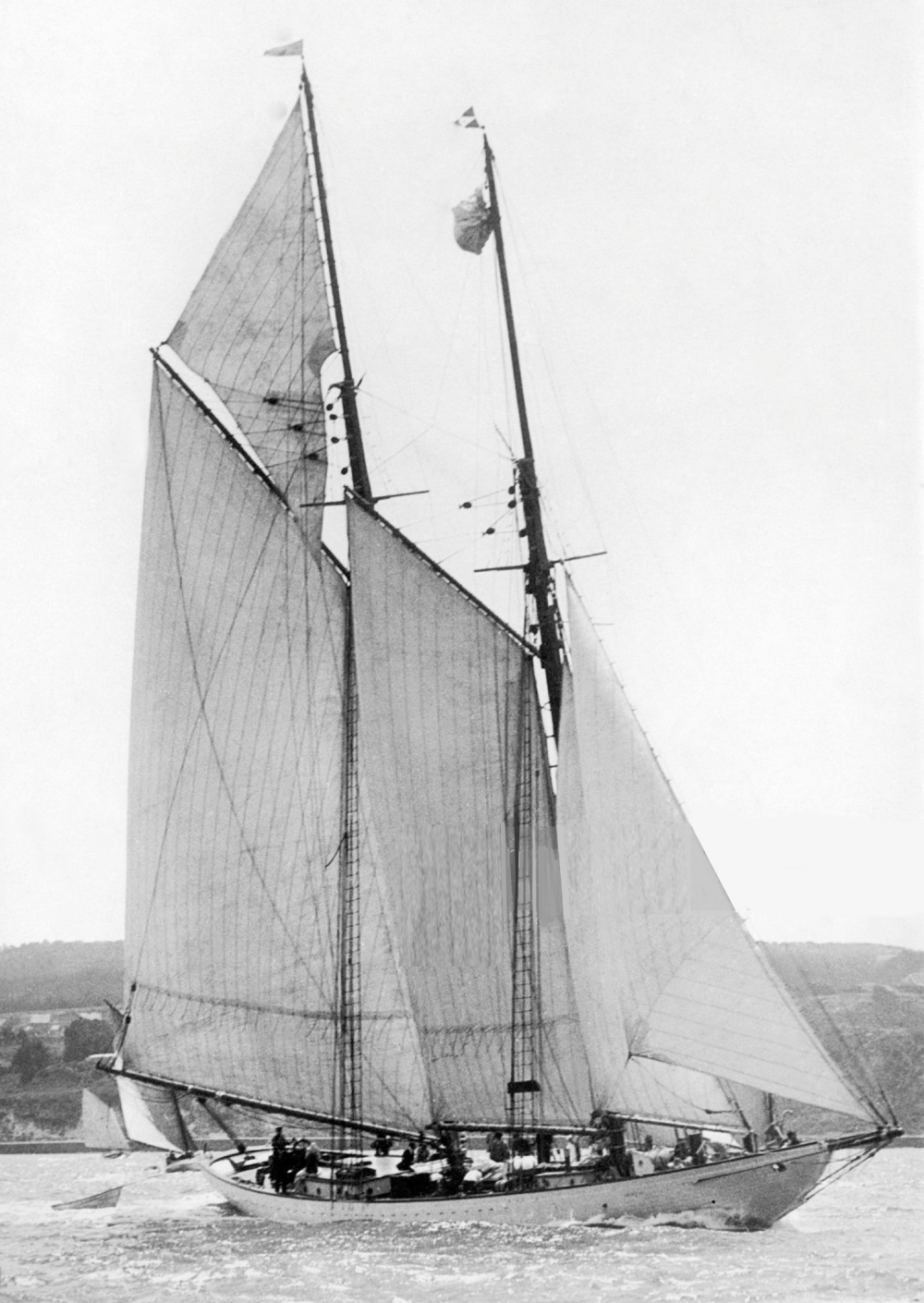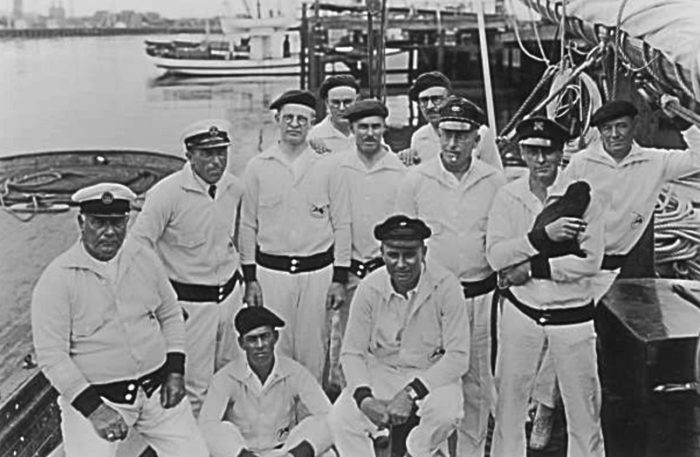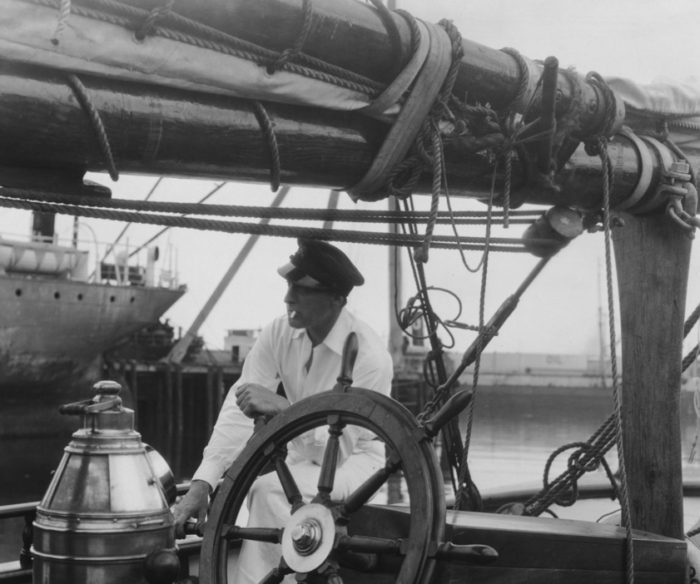
Sail Number:
Type: Two-Masted Schooner
LOA: 107’O″ / 32.61m – LOD: 93’0″ / 28.34m – LWL: 78’0” / 23.77m – Beam: 23’9″ / 7.24m – Draft: 11’0″ / 3.35m – Design Number: – Designer: Starling Burgess – Current Owner: – Year Launched: 1922 – Built By: Arthur D. Story shipbuilding, Essex MA – Hull Material: Wood – Gross Displacement: 94 tons – Net Displacement: 44 tons – Ballast: – Sail Area: -/ON: 222503
Historical:
Mariner was built by Arthur D. Story shipbuilding, Essex, Massachusetts, in 1922 as a Gloucester fisherman type. Arthur D. Story started this shipyard in 1872: when it closed in 1932, it had built 425 vessels, including the L. A. Dunton, Columbia, Gertrude L. Thebaud…etc
John Barrymore purchased Mariner January 1926 from Mr. L.A. Norris of San Francisco. She was skippered by Doc Wilson, the best known skipper on the coast. Mr. Barrymore purchased Mariner because of his love for the sea, wanting a craft which would be a racer as well as a sea home.
An expensive interior finish was placed as a substitute for the more modest furnishings which the craft has had in the past. The Mariner gained an International reputation during the summer of ‘25 when she won the yacht race from San Francisco to Tahiti, the longest ocean competition on record.
Following reconditioning and restoration of Barrymore’s auxiliary schooner Mariner, the noted actor sailed down the Mexican coast, accompanied by his director of “The Beloved Vagabond,” “Doc” P.H.L Wilson and party to Guadelupe Island, world famous as a hunting and fishing region.

“Captains Courageous,” is based on a classic book (adapted from a novel by Rudyard Kipling). It is both a film about high adventure and heartbreak. There is no better film about sailing than this. There is no better coming of age story than this. Loaded with Hollywood’s finest talent, it marked the first of Spencer Tracy’s Academy Award-winning performances for his unforgettable portrayal of Portuguese fisherman Manuel Fidello. He had back-to-back Oscar wins a year later when he won another for his Father Flannigan role in “Boys Town.” “Captains Courageous” was also nominated for best picture, editing and screenplay Oscars. Tracy actually didn’t like this particular performance until he won the Oscar. For one thing, his Portuguese accent was actually a fake Yiddish accent. No matter, he was great in this role.
This film is notable for its great sailing footage. A new type of camera setup called an “iron egg” was developed for this film to counteract the motion of rough seas. A 110-ft. two-masted schooner, Gretha F. Spinney, became Disko Troop’s ship We’re Here for the film, which was shot in Gloucester, Newfoundland and off the coast of California, as well as on Hollywood sound stages. For thrilling race scenes, the Mariner, a former Gloucester fishing ship owned by John Barrymore stood in for the rival ship Jenny Cushman. These two magnificent ships under full sail, close hauled, straining into the wind, roaring along the Grand Banks is a thing of awe-inspiring beauty and power. These scenes are as good as any America’s Cup racing footage you’ll ever see. The actors are wonderful, but these two majestic ships are the real stars of this film.
Barrymore wed Dolores “Jiggie Wink” Costello November 24, 1928. They honeymooned on his yacht Mariner along the coast of Panama
Barrymore sold his beloved schooner MARINER after his 1928 honeymoon cruise to the Galapagos Islands and South American coast, and commissioned Geary to design a 120′ twin-screw diesel cruiser as a replacement.
Known Racing History:
August , 1923 – (2,200 mile Santa Barbara to Honolulu Yacht Race) Mariner won the Sir Thomas Lipton Silver Cup and held the cruising record of 11 days, 14 hours, 46 minutes for 26 years, the longest a TransPac record ever stood.
June 10, 1925 – (3,700 mile race) Four boats started from San Francisco Bay, led by the redoubtable L.A. Norris, whose 107-foot schooner, Mariner, made Papeete in 20 days.

Mariner wins the Tahiti race by Annie Sutter – Mariner finally tacked to clear Mile Rock and stand out to sea, and it was then that near tragedy struck. Because of a stiff 20 knot wind, Norris decided to take in the main gaff topsail. Marinus Hansen went aloft to furl the sail, was thrown from the boat by a sudden lurch, and plummeted 75’ into the sea. Crewman Mike Beatie flung him a buoy which he clung to, and Mariner tried to come about to rescue Hansen. A 40 knot wind coupled with a strong ebb tide prevented them from reaching him before he was picked up by the Zellerbachs in their spectator boat Missawii. He was rushed to Letterman’s Hospital where he was treated for crushed lungs, and Mariner continued on her race.
Norris, who had sailed to Tahiti several times, decided to sail Mariner on the great circle course, hoping that her length would enable her to run away from the others. Fontana took his Shawnee on the same course; the skippers of Idalia and Eloise thought otherwise and determined to sail eastward to avoid the doldrum belt. Within a week Mariner had drawn slightly ahead of Idalia, and Eloise and Shawnee were out of the winning circle due to centerboard trouble and blown out sails. It was apparent that the test would be between Mariner and Idalia. Sailing their diverging courses, Norris was proven right as he kept to the great circle course. Parker picked up the doldurms while trying to avoid them; Norris passed through them in three days. She flew the remaining 2100 miles in 11 days with an average speed of 190 miles per day. She finished a week ahead of Idalia with an elapsed time of 20 days, 11 hours and 30 minutes. Jim recalls that the most frightening he ever was on the voyage was when they had almost arrived. They raised Pt. Venus Light at the entrance to Papeete Harbor at midnight of the 20th day, and Norris didn’t dare to go in the narrow entrance through the reefs in the dark. As they lay hove to outside the reefs, bobbing and rolling, Norris said to Jim, “Boy, go up and clear the wind pennant.” So Jim crept up the 115’ mast to clear the windsock, climbing around hoops holding the huge sails which remained set so they could sail into the channel at dawn. “The hoops were greasy and the mast was whipping I was scared to death and tired from being up all night but 1 had to do it.” Then Papeete’s pilot, an old friend of Norris’s came aboard and Jim suspected that Norris, who never took a drop to drink at sea, then and there began observing arrival procedures. At dawn they threaded their way into the channel to find, first, irate immigration officials furious that the pilot had boarded without clearance, and second, an invitation from the Governor of Tahiti to a champagne party at 6 a.m. From then on it was party time. Jim says, “everybody was entertaining us. Pretty girls took us on picnics to beautiful spots at freshwater pools they didn’t bring anything but mats to sit on and they gathered breadfruit and bananas and fresh shrimp from the streams. I didn’t care if Painless Parker or Fontana ever got there.” Norris and the officials were worried though, for the yachts had no radios on board, and a seven day lead was a long one. They worried about what might have happened when the yachts passed through the dangerous reefs of the Tumotos. But, after the seven day lapse, they arrived, one, two and three, over a period of three days.
The 20 day record that Mariner (“Queen of the Pacific”) set on that Tahiti Race has never been beaten. However, that might be because it has never been raced again in all the years since.
Provenance The Wall of Remembrance – The Owners, Crew & Notable Guest:
Owner/Guardian: (1923-1926) – L.A. Norris. San Francisco Yacht Club
Race Crew: Bob Hellen
Race Crew: Walter Beattie
Race Crew: James Wyatt
Owner/Guardian: (1926) – “Doc” H. L. Wilson, Los Angeles. California Yacht Club (purchased for $50,000 +)
Owner/Guardian: (1926-1929) – John Barrymore
Captain: Otto Maitthies, San Pedro
Owner/Guardian: Max L. Gordon, Los Angeles
Owner/Guardian: (1931) – Paul White, Santa Monica
Sources
Catalina Islander
Comments
Denise Barrymore – August 24, 2021
The Mariner was also the schooner which was used in the early scenes for the 1932 film ‘THE MOST DANGEROUS GAME’ starring Joel McCrea and Fay Wray. I recognised it instantly but if you look closely in certain footage of the yacht’s stern, you can see the name Mariner!
